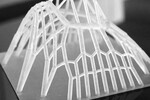Letterlocking is the historical practice of folding and sealing letters to become their own envelope. Before the proliferation of mass-produced gummed envelopes in the 1830s, most letters were sent via letterlocking. Hundreds of different letterlocking styles have been cataloged, including some with built-in tamper-evident locking mechanisms, enabling the intended recipient to detect so-called "man-in-the-middle" attacks. Most of what we know today about letterlocking has been deduced from careful examination of opened letterpackets; in this project we introduce a method for studying sealed letters using x-ray imaging and a new "virtual unfolding" process – allowing us to read and analyze locked letters without opening them.
The virtual unfolding pipeline, co-developed with Holly Jackson, creates a 3D reconstruction of the folded packet using data collected by a high resolution microtomograpy scanner, originally designed to study teeth. The scanner creates a 3D x-ray image of the letterpackets, revealing their inner contents. After we compute a transformation that unfolds the 3D geometry of the letterpacket to a flat state, we are able to create an image depicting what the letterpacket would look like if it were opened. Once generated, we sent these images to paleographers on our team to be translated. For more info about this multidisciplinary effort, please see our accompanying Nature Communications article.

3D rendering of an unopened letterpacket virtually unfolding via a physics simulation. This work is closely related to prior work I've done on simulating folded origami. All code from this project is freely available on Github and our original datasets can be found on Dataverse.

The Brienne Collection, a trunk preserving 300-year-old undelivered post, provided our team a rare opportunity to study unopened (still sealed) locked letters. The trunk originally belonged to postmasters Simon and Marie de Brienne, central figures of the early European postal system, living in The Hague, Netherlands. Back then, mail recipients paid for postage, so the Brienne’s kept this undelivered mail in the hopes that someone would come claim it for a fee. The trunk, nicknamed "the piggy bank" (spaarpotie), was rediscovered in 1926 and currently resides at the Dutch postal museum in The Hague. The collection contains 3148 cataloged items, including 2571 opened letters, fragments, and other documents, and 577 letterpackets that have never been opened. Photo courtesy of Sound and Vision The Hague.

Single cross-sectional slice of x-ray microtomography (XMT) scan of 11 letterpackets from the Brienne Collection, imaged by our collaborators at the Institute of Dentistry at Queen Mary University of London. In these scans we can see the individual layers of paper within the folded packets. Iron gall inks commonly used in the period show up as bright regions in the scan due to their high metal content. Also visible are bright regions of seals, sand, and glue.
Several of our virtual unfolding results are shown below. Remember, these are not photographs of opened letters, they are renderings generated from our computational pipeline (with pseudo-color added for clarity). The original letterpackets are still sealed and have never been opened since they were originally created over 300 years ago. Beyond displaying the ink on the surface of the paper, the reconstructions we've generated show additional features of the handmade paper from the period including watermarks and a patterning of laid and chain lines.




 ORIGAMI SIMULATOR
ORIGAMI SIMULATOR
 DIGITAL MARBLING
DIGITAL MARBLING
 STRUCTURAL SIMULATIONS
STRUCTURAL SIMULATIONS
 SHELL FORM FINDING
SHELL FORM FINDING
 WEBGL SHADERS
WEBGL SHADERS





